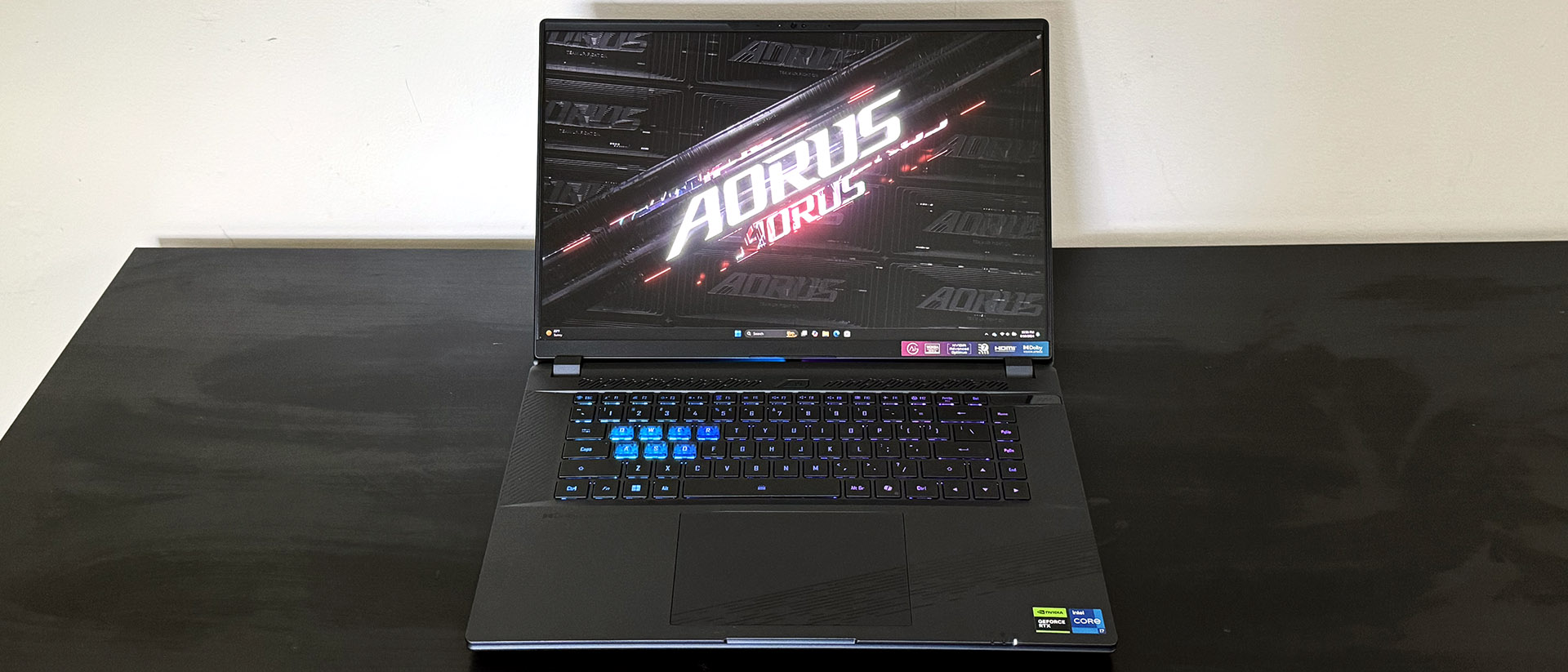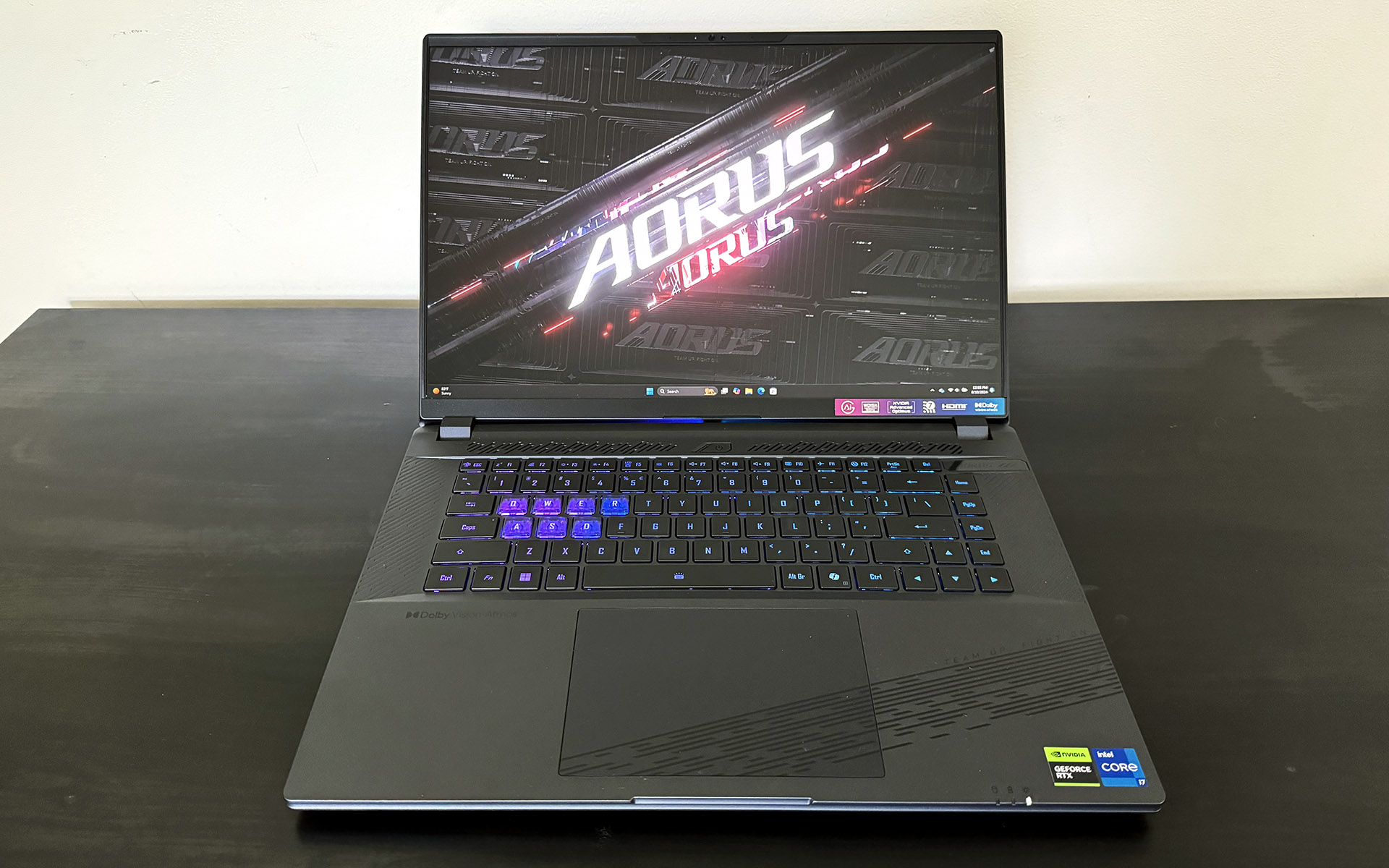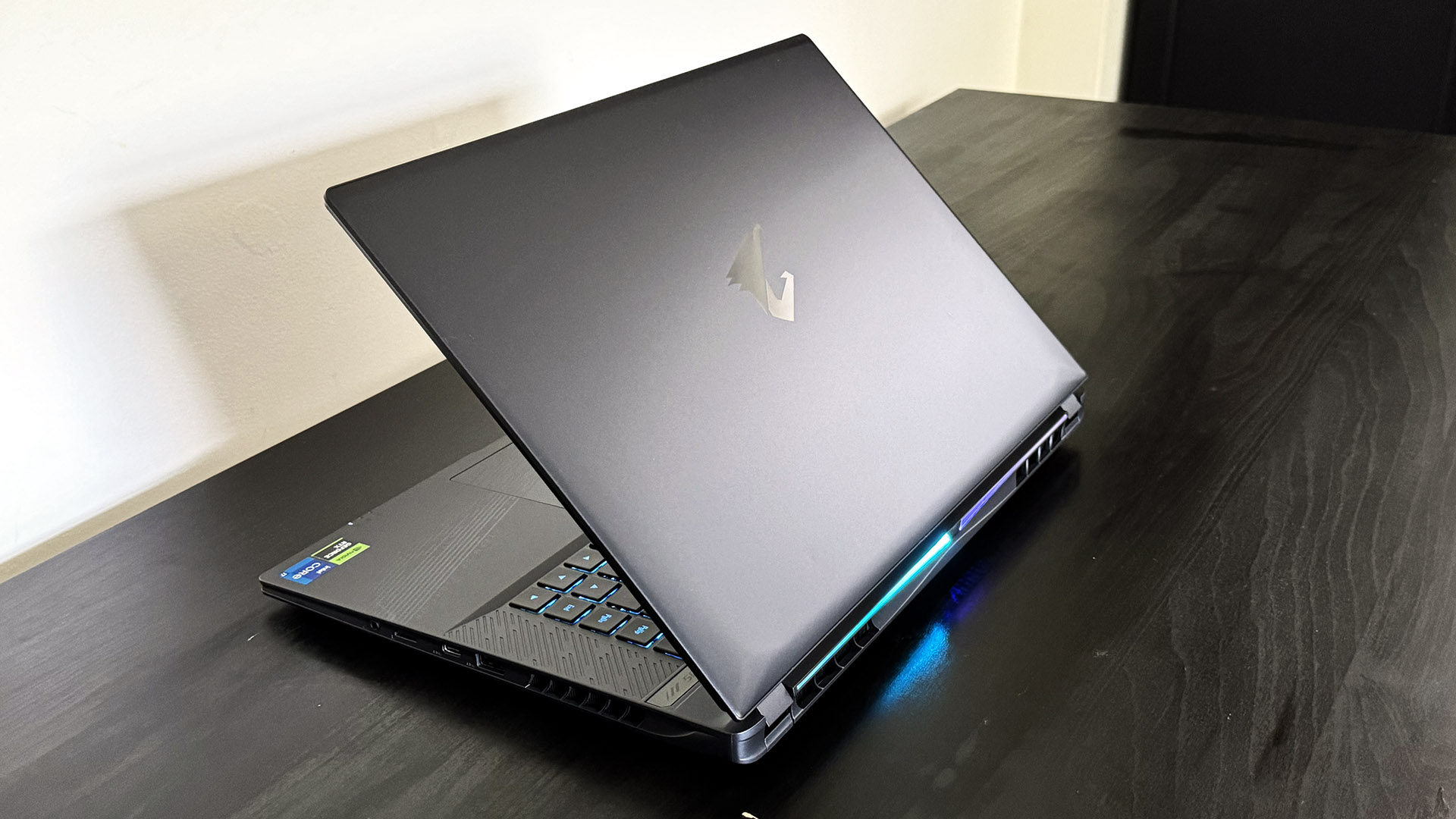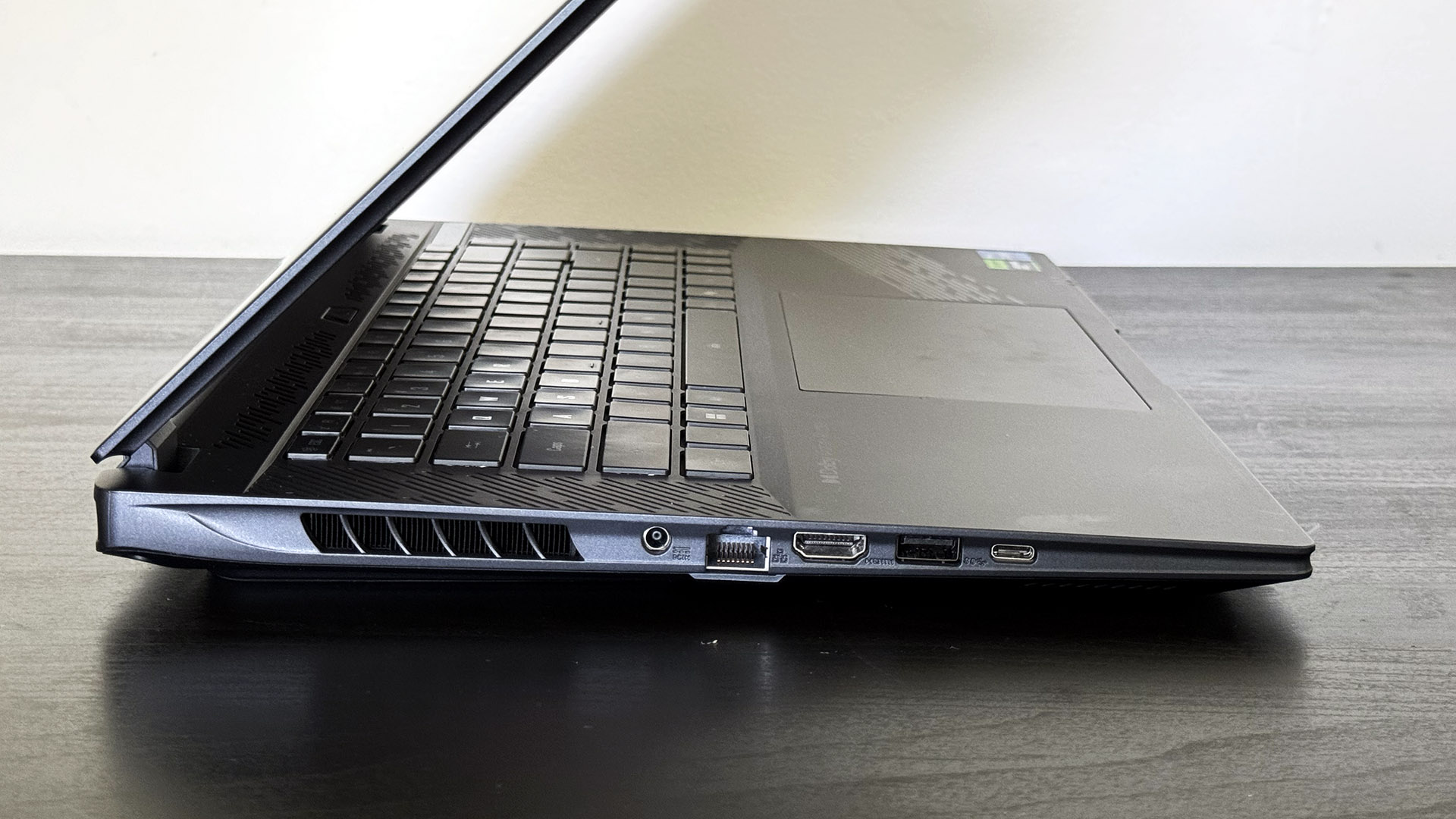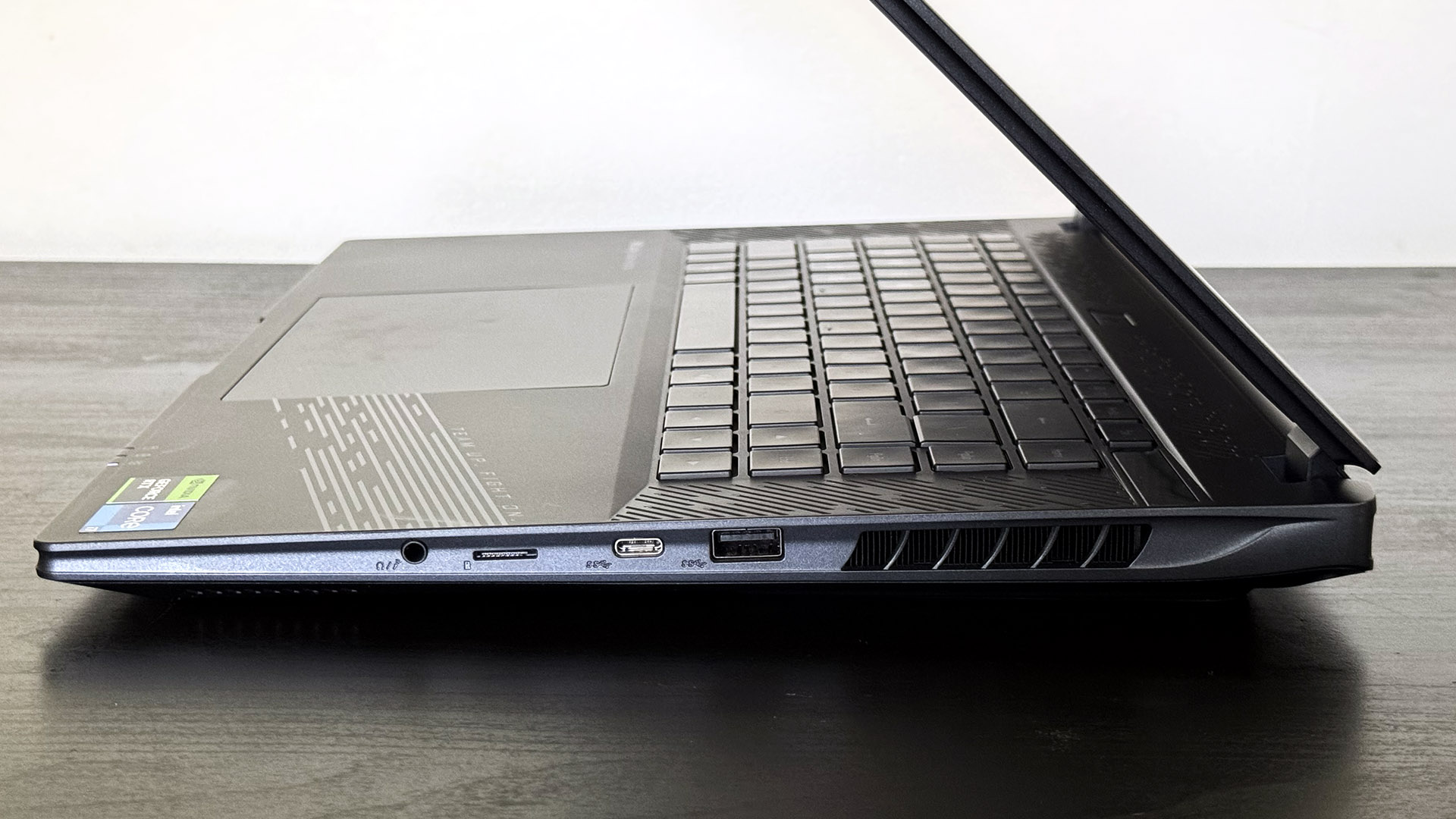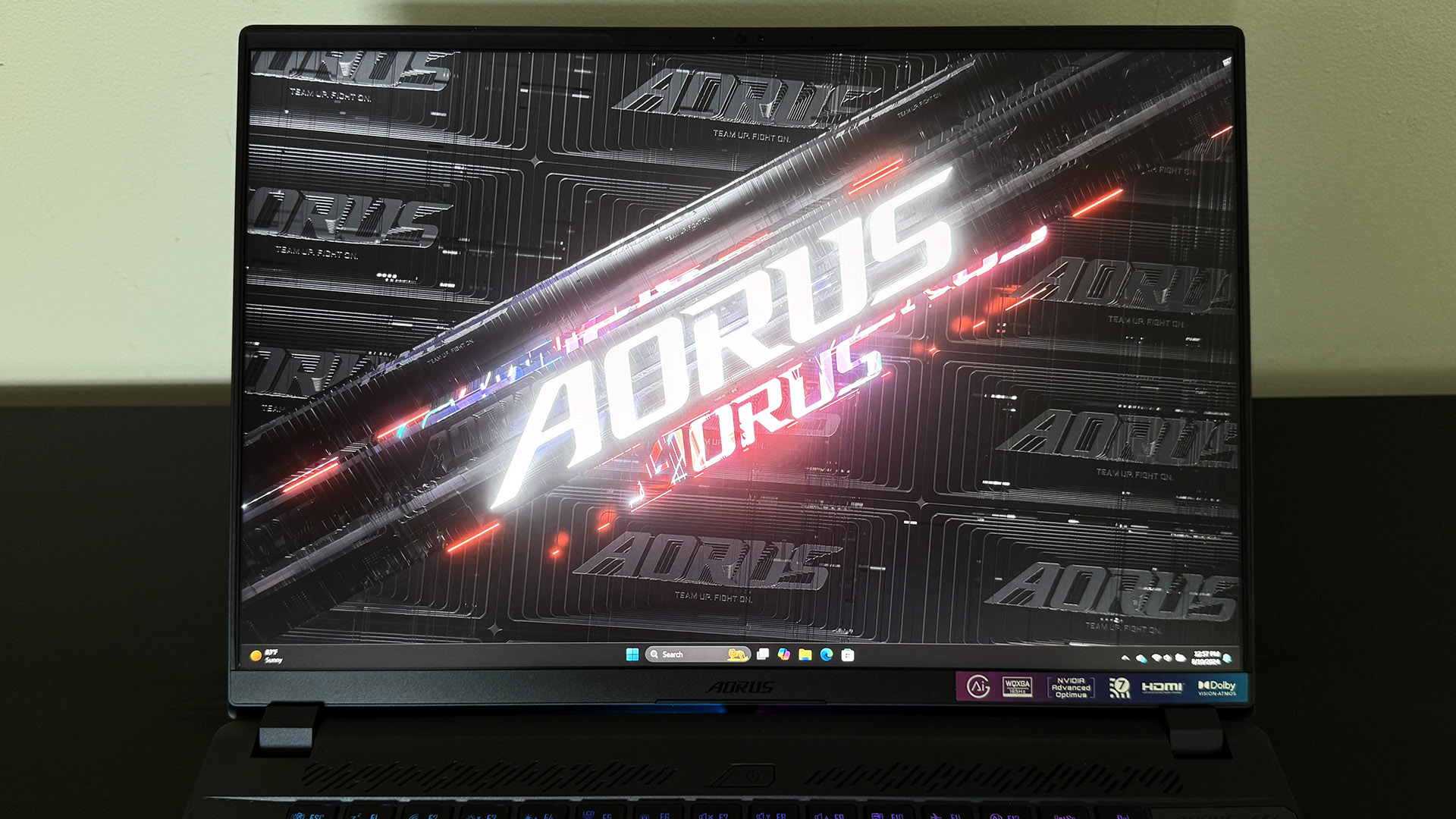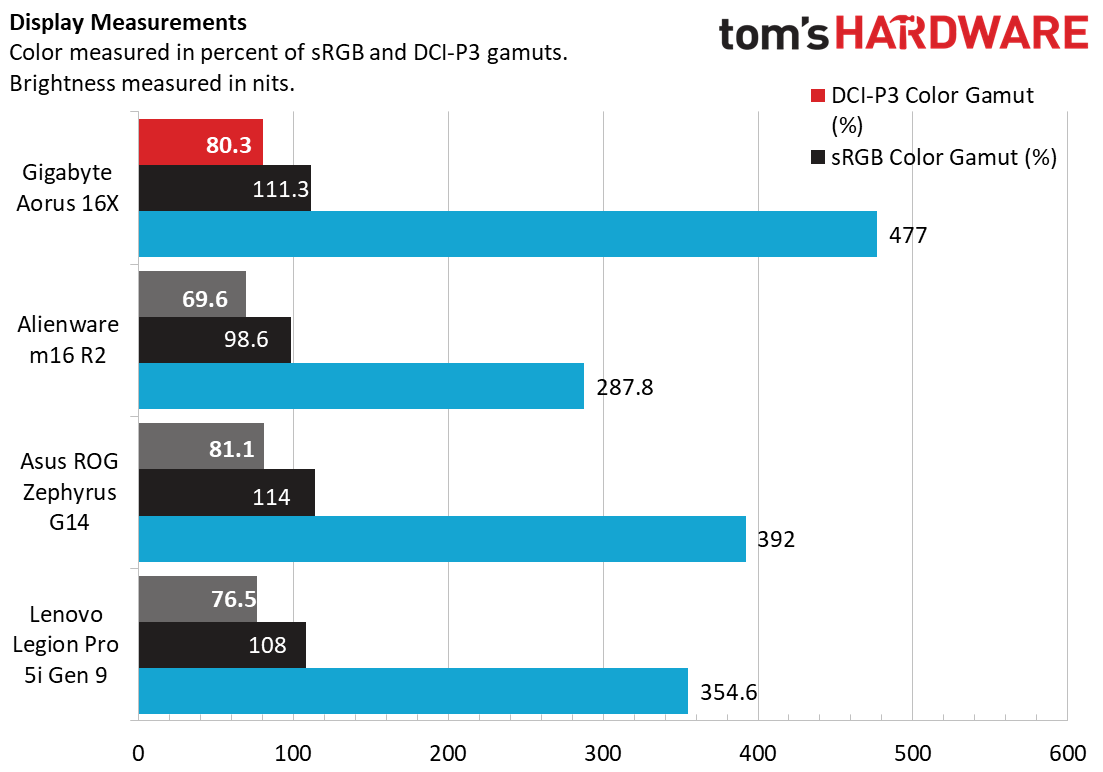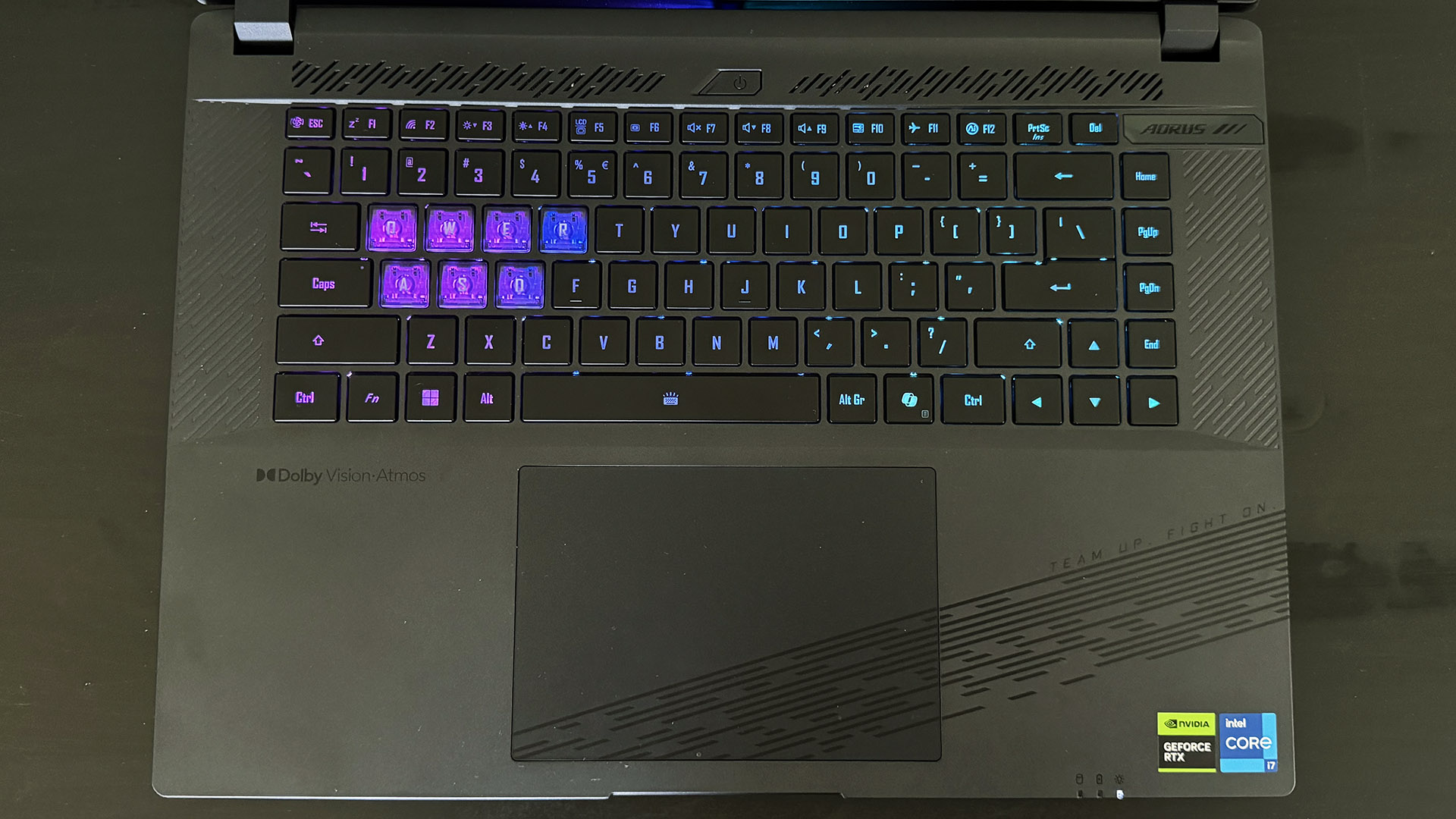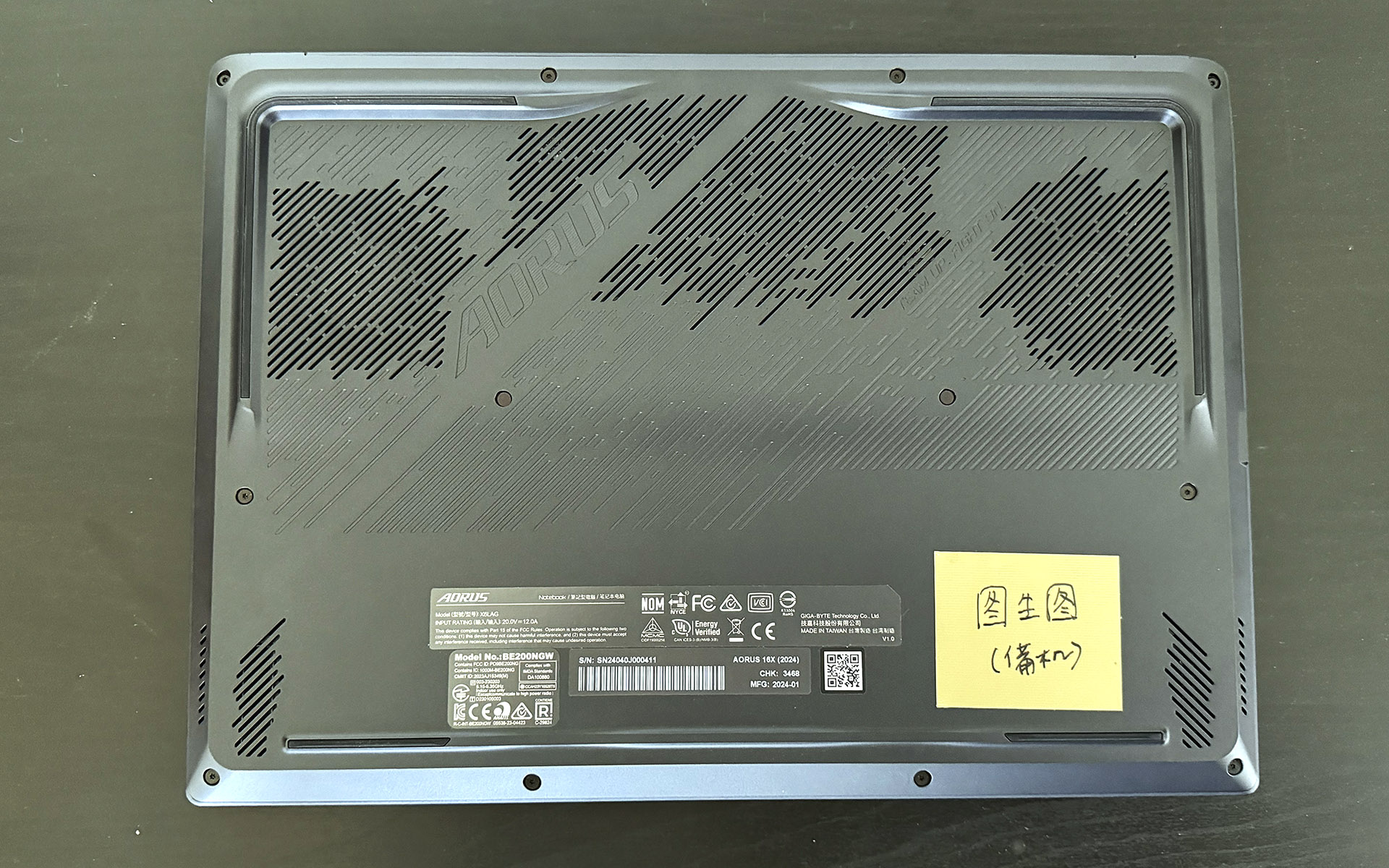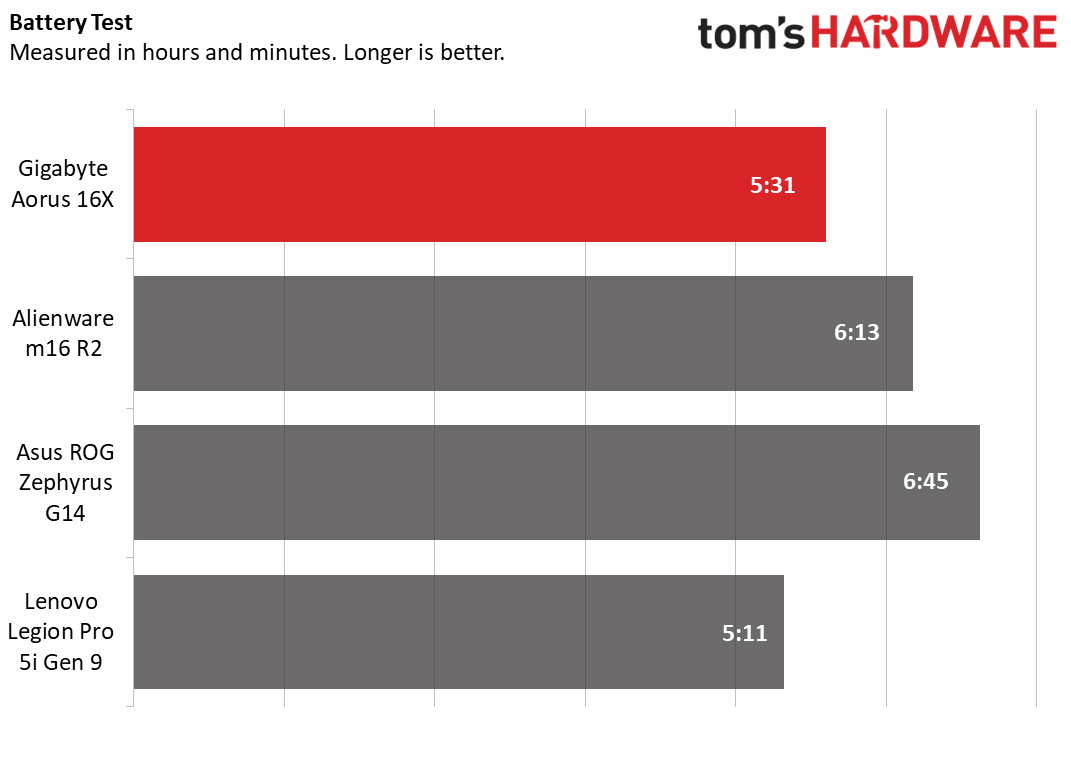Tom's Hardware Verdict
Gigabyte’s Aorus 16X delivers excellent gaming performance, a colorful screen, solid speakers, and all-around practicality for a price that makes it hard to pass up.
Pros
- +
Well-priced
- +
Vibrant screen
- +
Thunderbolt 4 and Wi-Fi 7. IR webcam
- +
Supports two storage drives
Cons
- -
Mediocre battery life
- -
Unintuitive software
Why you can trust Tom's Hardware
The Gigabyte Aorus 16X ($1,599.99 as tested) is an excellent all-around device that can rival some of the best gaming laptops. This midrange 16-inch model offers impressive performance with its Intel Core HX-class processor and Nvidia GeForce RTX 4070 graphics card. It excels in nearly every area, particularly its screen, and practical features, including a comfortable keyboard and IR webcam, also make it suitable for everyday use when not gaming. While we wish the battery life lasted longer, there’s still plenty to appreciate here.
Design of the Gigabyte Aorus 16X
The Aorus 16X’s "midnight" gray chassis looks more like black in person. It makes no attempt to hide that it’s a gaming laptop, with aggressive cooling vents, an RGB lightbar and keyboard, and flashy detailing on the palm rest.
The laptop is built with sturdy plastic used in the chassis and aluminum on the lid. The lid opens only 45 degrees past vertical; I’d like to see it go a full 180 degrees. Looks-wise, Aorus’ reflective lid logo and badge don’t really stand out, though the lightbar running along the bottom edge is bright and projects Aorus’ logo about an inch behind the laptop for a touch of uniqueness. The Gigabyte Control Center app provides different color schemes and patterns (pulse, rainbow wave, static, and color cycling). The lighting can, of course, be disabled. I liked it and kept it enabled.
The inside of this laptop is also flashy, with vents across the top of the keyboard and textured patterns flanking it. The “Team Up, Fight On” lettering on the palm rest isn’t my taste, but the printed lines running through the touchpad add flair. The Aorus 16X pulls off the aggressive look successfully.
At 14.02 x 10 x 1.06 inches and 5.07 pounds, the Aorus 16X has about the same footprint but is lighter than the Lenovo Legion Pro 5i Gen 9 (14.3 x 10.25 x 1.05 inches, 5.51 pounds) and the Alienware m16 R2 (14.33 x 9.81 x 0.93 inches, 5.75 pounds). It’s not quite as slim as the Alienware.
The Aorus 16X’s abundant connectivity starts on the left edge with Ethernet, HDMI video output, a USB Type-A port, and a USB Type-C port. Both USB ports are version 3.2 Gen 2 (10 Gbps). The USB-C port supports DisplayPort 1.4 video output. The barrel-style AC power jack is also here.
I dislike that some of the ports are further forward (towards the user) than the chassis midpoint; if you’re left-handed, peripherals plugged into these ports may intrude into your external mouse space. At least the cooling vents are far enough back that the exhaust air shouldn’t reach your hands.
Get Tom's Hardware's best news and in-depth reviews, straight to your inbox.
Ports on the right include a 3.5 mm headphone/microphone combo jack, a MicroSD card reader, a Thunderbolt 4 USB Type-C port, and another 10 Gbps USB-A port. Thunderbolt 4 port is big plus; the Legion Pro 5i Gen 9 doesn’t have it.
Wireless connectivity comes from an Intel BE200 networking card supporting the latest Wi-Fi 7 and Bluetooth 5.4 standards.
Gigabyte Aorus 16X Specifications
| CPU | Intel Core i7-14650HX (8 Performance and 8 Efficient cores, 5.2 GHz P-core Turbo Boost, 55W base power) |
| Graphics | Nvidia GeForce RTX 4070 (8GB GDDR6, 2,175 MHz boost clock, 140W maximum graphics power) |
| Memory | 32GB DDR5-5600 (2x 16GB SODIMM) |
| Storage | 1TB SSD |
| Display | 16-inch, 2560 x 1600, 16:10, IPS, 165 Hz, Advanced Optimus |
| Networking | Intel Wi-Fi7 BE200, Bluetooth 5.4 |
| Ports | Thunderbolt 4 USB Type-C, HDMI 2.1, 2x USB 3.2 Gen 2 Type-A, USB 3.2 Gen 2 Type-C (supports DisplayPort 1.4), Ethernet, 3.5 mm headphone/microphone, MicroSD reader |
| Camera | 1080p |
| Battery | 99 WHr |
| Power Adapter | 240 watts (barrel connector) |
| Operating System | Windows 11 Home |
| Dimensions (WxDxH) | 14.02 x 10 x 1.06 inches (356 x 254 x 27 mm) |
| Weight | 5.07 pounds (2.3 kg) |
| Price (as configured) | $1,599.99 |
Gaming and Graphics on the Gigabyte Aorus 16X
Our Aorus 16X has an Intel Core i7-14650HX processor, an Nvidia GeForce RTX 4070 laptop graphics card (140W), and 32GB of RAM. It’s well equipped for modern gaming.
Playing Crysis 3 Remastered at 2560 x 1600 with Very High details, I saw between 75 and 85 frames per second indoors and almost 100 fps outdoors. The game was very smooth and didn’t lag at all.
Our comparison systems include the Alienware m16 R2 (Core Ultra 7 155H, RTX 4070 140W, $1,899.99 as tested), the Lenovo Legion Pro 5i Gen 9 (Core i7-14650HX, RTX 4060 140W, $1,313.99 as tested), and the Asus ROG Zephyrus G14 (AMD Ryzen 9 8945HS, RTX 4070 90W, $1,999.99 as tested). The latter is a 14-inch gaming laptop and isn’t as powerful as the others, but it will show what can be done in a more portable form factor.
We use the 1080p resolution numbers for apples-to-apples comparisons, but we also include results from running at the laptop’s native screen resolutions. The Aorus 16X, Alienware, and Legion are all 2560 x 1600 while the Asus is 2880 x 1800.
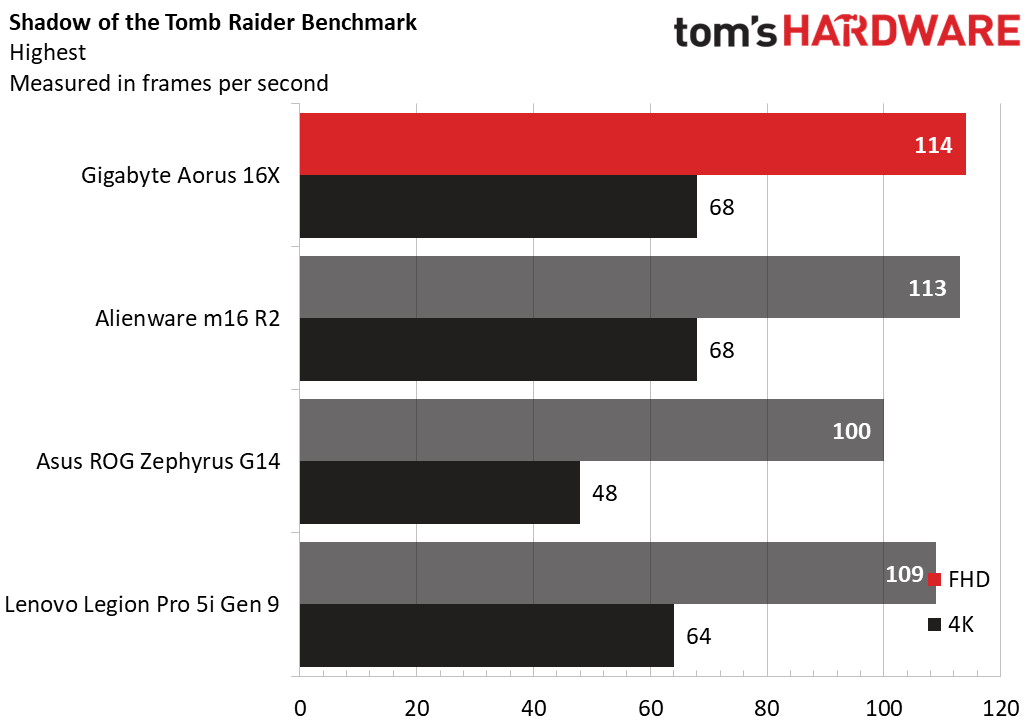
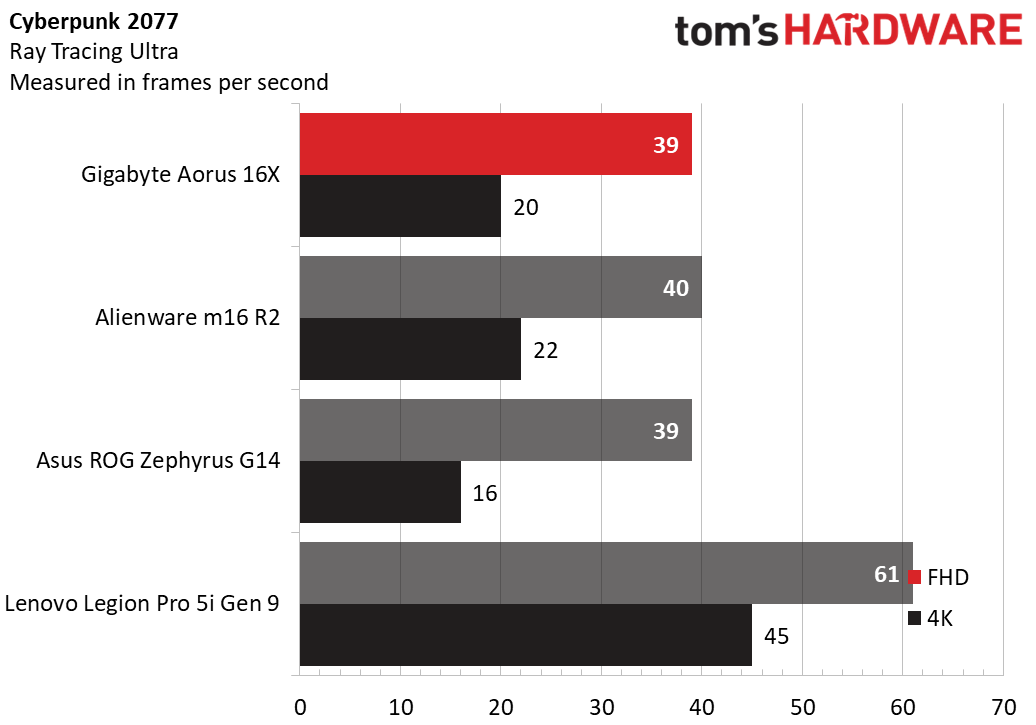
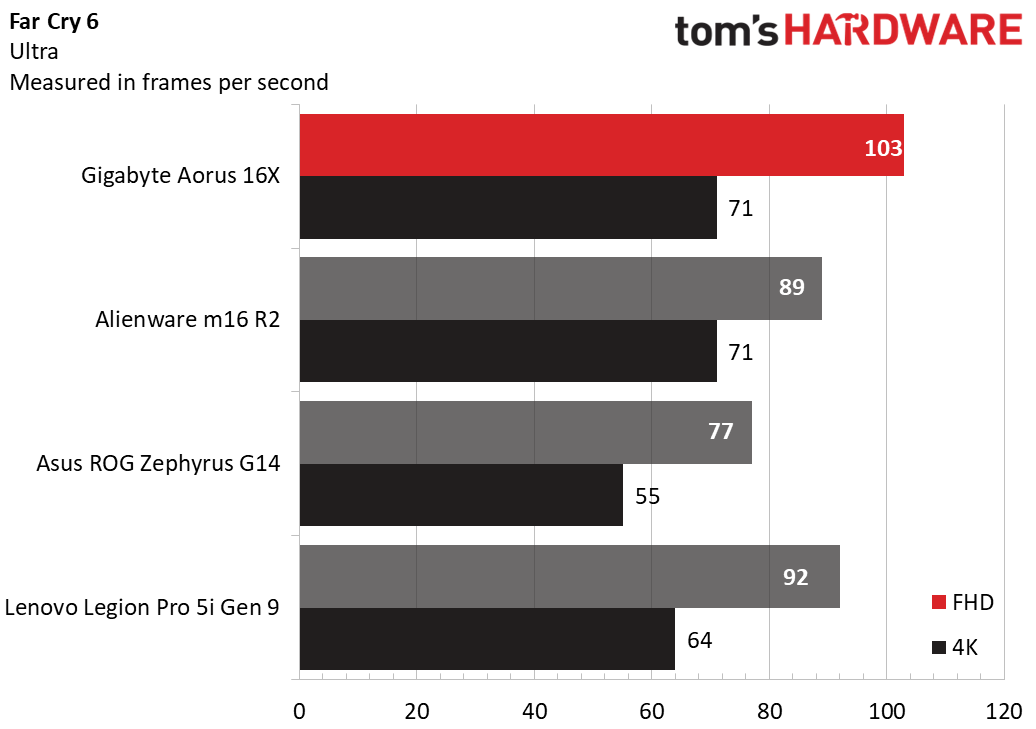
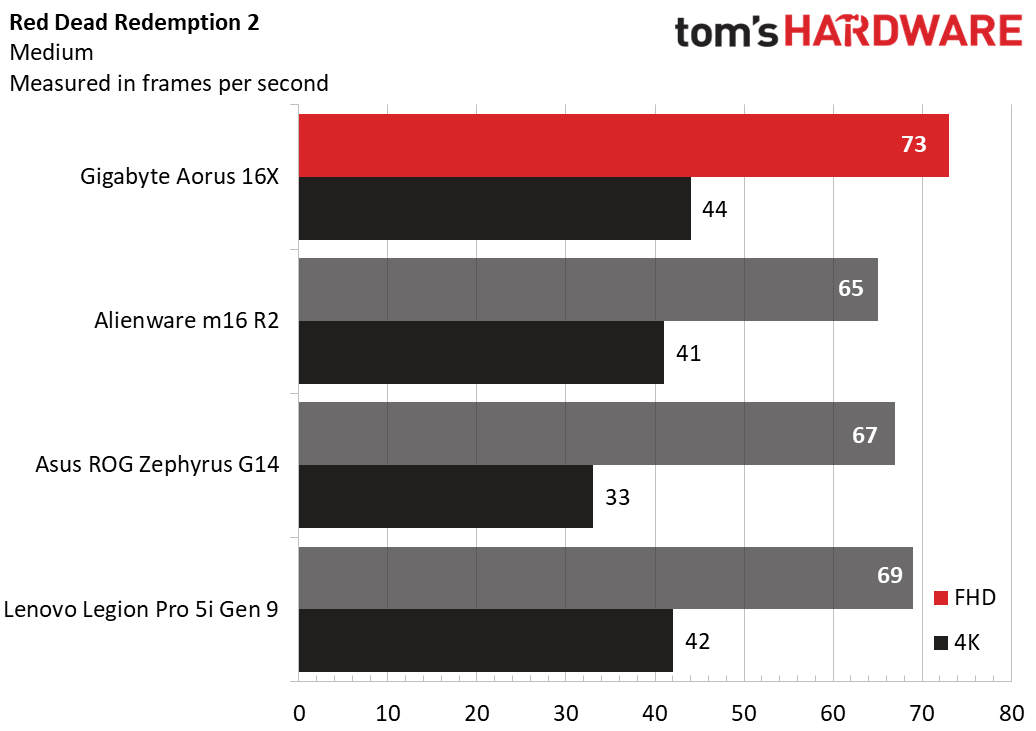

In Shadow of the Tomb Raider (Highest details preset), the Aorus 16X achieved 114 fps at 1080p and 68 fps at 1600p, almost matching the Alienware’s 113 fps and 68 fps. The Legion, equipped with an RTX 4060, was close behind with 109 fps and 64 fps. Meanwhile, the Asus reached 100 fps at 1080p but dropped to 48 fps at its native resolution.
Cyberpunk 2077 (Ray Tracing Ultra) was tough for all these units. The Aorus 16X and the Alienware were close, with the Alienware slightly ahead at 1600p, scoring 22 fps against the Aorus’s 20 fps. The Legion performed significantly better for reasons that aren’t clear to us, while Asus predictably picked up last place.
The Aorus 16X’s 103 fps at 1080p in Far Cry 6 (Ultra) was much better than the Alienware’s 89 fps and the Legion’s 92 fps. It tied the Alienware at 1600p, with 71 fps.
Red Dead Redemption 2 (Medium) was another good showing for the Aorus 16X; its 73 fps at 1080p bested the Alienware’s 65 fps and Legion’s 69 fps. Its 44 fps at 1600p was also the best number, with the Alienware and Legion trailing with 41 and 42 fps, respectively.
Borderlands 3 (at the game’s “Badass” settings) was another photo finish for the Aorus 16X and Alienware at 1080p at both resolutions. The Legion took a backseat here, with just 61 fps at 1600p compared to the Aorus’ 66 fps.
The Aorus 16X and Alienware were closely matched, which isn’t surprising since most of our games are GPU-limited and both use an RTX 4070 rated at 140W. Interestingly, the Legion performed similarly with its 140W RTX 4060, indicating minimal difference between it and the RTX 4070 at the same power rating. Wattage indeed matters; the Asus, with its 90W RTX 4070, couldn’t match the Aorus 16X’s performance.
For stress testing, we simulate half an hour of gaming by running the Metro Exodus benchmark 15 times at RTX settings. During the test, the Aorus 16X averaged 82.1 fps with fluctuations of only one or two fps between runs, suggesting its cooling system keeps temperatures very stable. The Core i7-14650HX’s P-cores had an average clock of 2.95 GHz and the E-cores 2.35 GHz and respective average temperatures of 60 and 63 degrees Celsius. The RTX 4070 had an average core clock of 2.36 GHz and an average temperature of 64 degrees.
Productivity Performance on the Gigabyte Aorus 16X
Our Aorus 16X review unit has a Core i7-14650HX processor, 32GB of RAM, and a 1TB SSD.
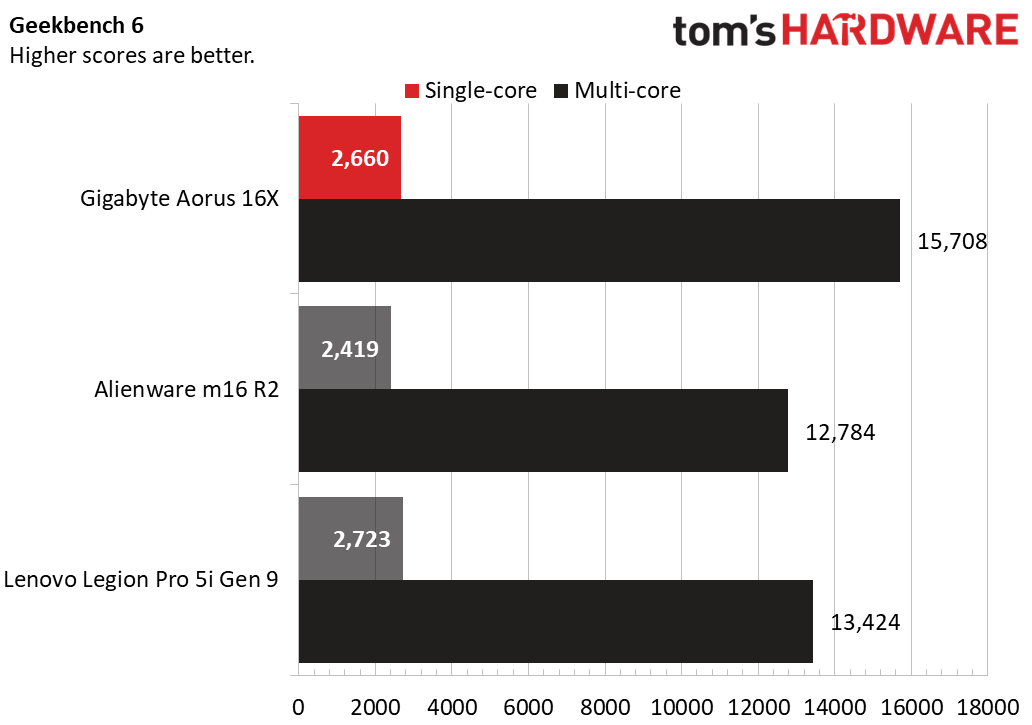
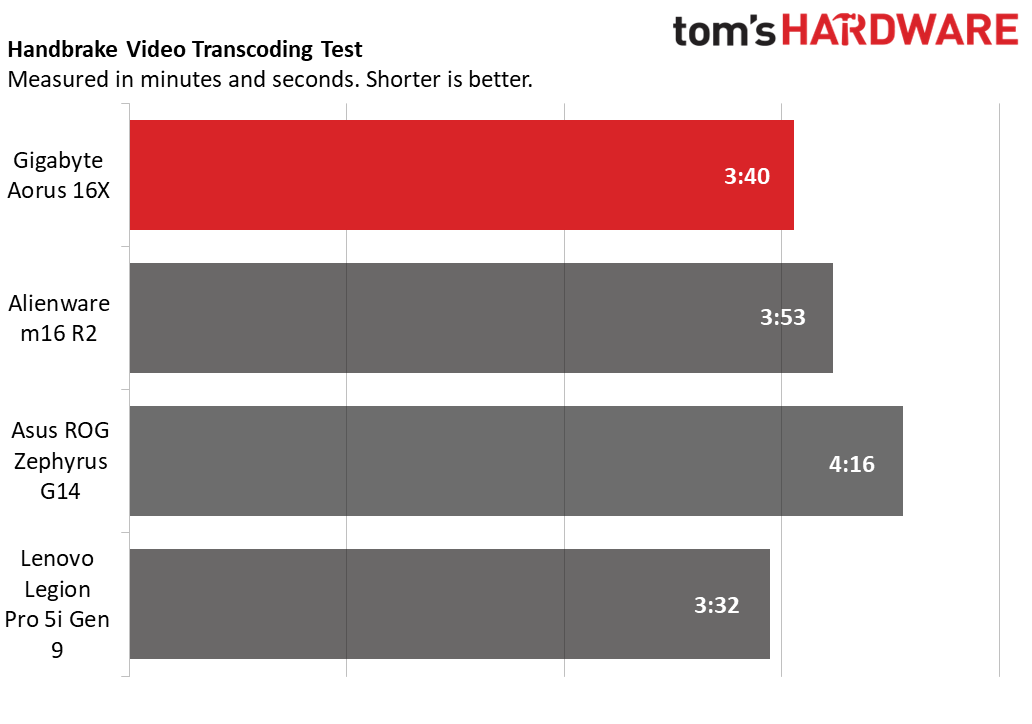
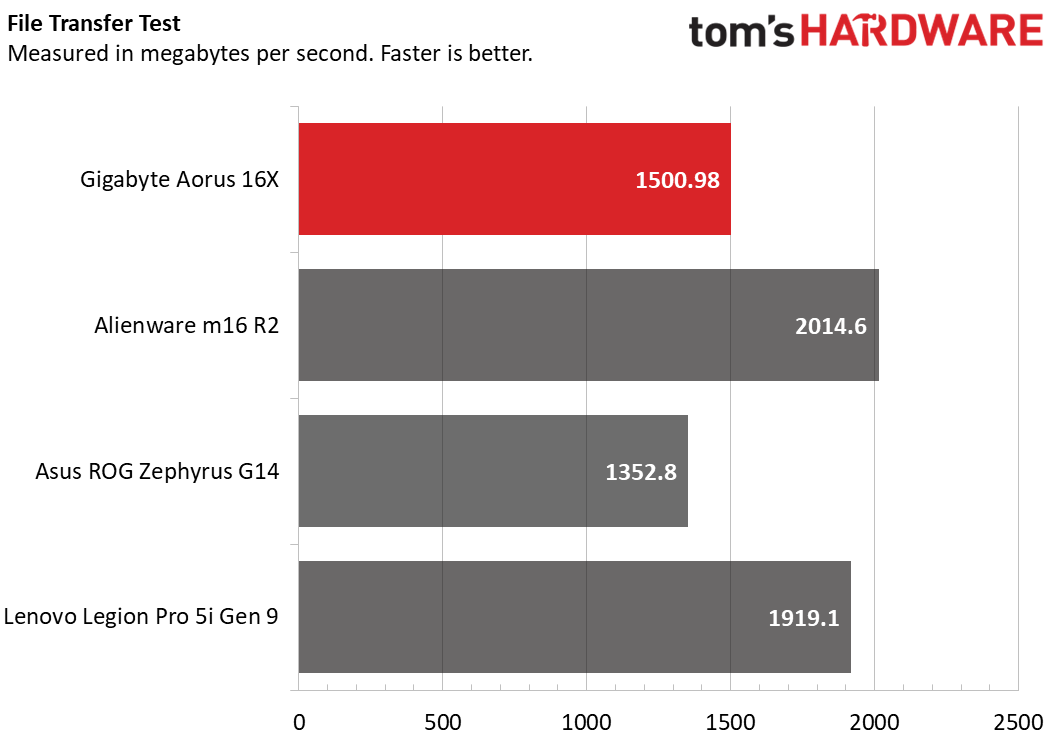
In Geekbench 6, the Aorus 16X was just off the Legion’s pace in the single-core test, with 2,660 against 2,723 points, but it leapt ahead in multi-core with 15,708 to 13,424 points. The Alienware’s Core Ultra 7 chip lagged despite being of a newer architecture, though in fairness, its processor has a 45W base power rating whereas the Core HX-class chips are 55W.
In the Handbrake test, the Aorus 16X finished in 3 minutes and 40 seconds, just behind the Legion’s 3:32. The Alienware followed at 3:53, while the Asus had the slowest time at 4:16.
The Aorus 16X had a middling score of 1,500.98 MBps in our 25GB file transfer test, lagging the Alienware’s 2,014.6 MBps and Legion’s 1,919.1 MBps but well ahead of the Asus’s 1,353.8 MBps.
Display on the Gigabyte Aorus 16X
If you don't care about OLED, you’ll be hard-pressed finding a better display on a midrange 16-inch gaming laptop than the one on the Aorus 16X. Its 2560 x 1600 resolution works out to a 16:10 aspect ratio. Gaming-friendly specifications include a 165 Hz refresh rate and an anti-glare surface. There is no Nvidia G-Sync support.
The picture is first rate; I appreciated the vibrant colors and deep contrast watching Disney’s Star Wars: Acolyte. The high brightness really helped animate lasers and lightsabers in battle scenes. The same qualities carried over into gaming, where the deep contrast helped me pick out enemies in Crysis 3 Remastered and the brightness made muzzle flashes and explosions seem realistic.
The Aorus 16X had the highest brightness of 477 nits, surpassing the Legion’s 355 nits and the Alienware’s relatively dim 288 nits. It was also brighter than the Asus, though its 392 nits is very good considering it uses OLED and not IPS like the others. The Aorus 16X also excelled in color reproduction, covering 80.8% of the DCI-P3 spectrum compared to the Legion’s 76.5% and the Alienware’s 69.6%.
Keyboard and Touchpad on the Gigabyte Aorus 16X
I thoroughly enjoyed typing on the Aorus 16X’s keyboard which felt satisfying and precise. The keys have a rubbery feel, but the cushion at the bottom of the keystroke prevents fatigue during longer typing sessions. I achieved an excellent (for me) 114 words per minute with 100% accuracy in the MonkeyType online typing test.
The translucent WASD cluster and Q, E, and R keys give this keyboard an obvious gaming focus. The specifications say it has three RGB backlighting zones, but I didn’t see a way to individually control them in the Gigabyte Control Center app; its effects (pulse, rainbow wave, static, and color cycling) apply to the entire keyboard. It’s probably a software oversight since I did observe parts of the keyboard being different colors, so the hardware is obviously capable. The Alienware m16 R2 offers more advanced per-key backlighting, but a similar model is several hundred dollars more expensive than this Aorus. The Legion Pro 5i Gen 9 offers an additional zone (a total of four) because it has a numeric keypad.
But I don’t miss a numeric keypad on the Aorus 16X; fitting one on a 16-inch laptop usually involves a compromise or two. (For instance, the Legion’s numeric keypad uses two-thirds width keys.) Gigabyte instead makes great use of the space by putting a column down the right edge with dedicated Home / PgUp / PgDn / End keys. Other layout highlights include a Copilot key and a full-size arrow cluster.
I also like the Aorus 16X’s huge touchpad. My fingers didn’t stutter across its matte surface even when it was humid, and physical clicks are quiet (if not silent) and feel satisfying.
Audio on the Gigabyte Aorus 16X
Good laptop speakers are like umbrellas; you might not actively seek them out, but they’re invaluable when needed. The Aorus 16X’s speakers are reliable if you forget your headphones or want to watch a movie with a friend. I noticed clear vocal separation and decent bass playing “Better off Alone, Part III” by Alan Walker, Dash Berlin, and Vikkstar.
The volume is more than sufficient for personal listening and seems distortion-free even at 100%. Watching Star Wars: Acolyte, I didn’t need subtitles to understand the dialogue. The soundstage was convincing enough, with clear separation between the left and right channels.
Dolby Atmos tuning deserves credit for much of the sound quality. The included Dolby Access app provides different equalizers and lets you create your own. I’d like to see a setting automatically switches between them depending on the media, but I had no complaints using Balanced as my all-around preset.
Upgradeability of the Gigabyte Aorus 16X
Servicing the Aorus 16X is a bit tricky due to the 12 Torx T6 screws of varying lengths securing its plastic bottom, so it’s crucial to remember their positions. I managed to free the panel’s clips using my thumb instead of a trim removal tool by pressing on a notch near the display hinges.
The Aorus 16X offers as much upgradeability as you can expect in a laptop, with two DDR5-5600 SODIMM slots and two M.2 2280 PCI Express 4.0 solid-state drive slots. One of the M.2 slots is empty so you can easily add a drive. It’s also refreshing to see that the wireless card is an easily replaceable M.2 2230 variant instead of being soldered. The battery is also replaceable; its 99.2 WHr limbos under the 100 WHr maximum allowed on airplanes per TSA regulations.
Battery Life on the Gigabyte Aorus 16X
Our battery life test includes simulated web browsing, streaming video over Wi-Fi, and running OpenGL tests with the screen brightness set to 150 nits. The Aorus 16X lasted 5 hours and 31 minutes, outlasting the Legion by 20 minutes but falling short of the Alienware by about 45 minutes (6:13) and the 14-inch Asus by over an hour (6:45). While the Aorus 16X has room for improvement, its battery life should allow you to work away from home for a morning or afternoon without needing the power adapter.
One reason the Aorus 16X gets the battery life it does is because of Nvidia Advanced Optimus, which automatically switches between the Nvidia GPU and the power-saving Intel integrated graphics built into the Core i7. I noticed a slight pause when the switch occurred, but it’s otherwise seamless. The Nvidia Control Panel or Gigabyte Control Center apps allow forcing the RTX 4070 to be always enabled.
[BATTERY MEASUREMENT CHART]
Heat on the Gigabyte Aorus 16X
We stress test gaming laptops by running the Metro Exodus benchmark at RTX settings 15 times to simulate half an hour of gaming. We measured 92 degrees Fahrenheit on the Aorus 16X’s keyboard between the G and H keys, 72 degrees on the touchpad, and the highest temperature we saw on the underside was 102 degrees. These temperatures are low for a gaming laptop – no part of it felt more than lukewarm to the touch.
The two cooling fans make a fair amount of noise while gaming, though it’s no louder than I’m used to from other laptops in this class. The built-in speakers get loud enough to drown out the fan noise.
Webcam on the Gigabyte Aorus 16X
The Aorus 16X’s 1080p webcam isn’t anything special but has sharp-enough video and handles low light without excessive grain. As with many 16-inch laptops, I must tilt the screen almost vertical for the camera to capture my head and upper body. For better video quality, check out our best webcams. I wish the camera had a kill switch or sliding privacy shutter.
The webcam’s infrared sensor provides the Aorus 16X with biometric capability with Windows Hello, something many gaming laptops often forgo.
Software and Warranty on the Gigabyte Aorus 16X
Gigabyte preloads only a few apps on the Aorus 16X beyond those included with Windows 11. The most important is the Gigabyte Control Center, which offers system monitoring and updates, settings adjustments, RGB lighting control, and fan curve customization. Settings include automatic adjustment of RGB lighting and screen refresh rate (dimming the lighting and lowering the refresh rate on battery) and limiting battery charge to extend its lifespan. The AI Nexus section allows you to switch between default power levels and shows whether the Nvidia GPU or integrated GPU is active. Additionally, the app lets you control the keyboard backlighting and rear lightbar. While it worked reliably, the interface could have been more intuitive.
The other important app is Dolby Access, which I mentioned in the audio section. Kudos to Gigabyte for not including any unwanted trial apps.
Gigabyte covers the Aorus 16X with a one-year warranty.
Gigabyte Aorus 16X Configurations
We reviewed the Aorus 16X model ASG-53USC64SH with a Core i7-14650HX processor, a GeForce RTX 4070 graphics card, 32GB of RAM, and a 1TB SSD. Newegg had it discounted to $1,599.99 from $1,629.99 at review time.
The only other configuration I found with a 14th gen Intel CPU was model ASG-63USC65SH, which bumps the CPU to a Core i9-14900HX and doubles the storage to 2TB for $1,719.99, on sale from $2,099.99. There doesn’t appear to be a budget model, but I did see model 9KG-43USC54SH for $1,999.99 with a Core i5-13650HX, a GeForce RTX 4060, 16GB of RAM, and a 1TB SSD. All the Aorus 16X configurations appear to use the same 2560 x 1600 screen.
Our Aorus 16X is significantly more affordable than the $1,999.99 Alienware m16 R2. The Lenovo Legion Pro 5i Gen 9 is a competitive value; the $1,313.99 model we tested (which had risen to $1,459.99 by the time of this review) performed similarly in our gaming tests despite using an RTX 4060 and only having 16GB of RAM. A more comparable RTX 4070 model was $1,829.99 at Best Buy and included a Core i9. Overall, the Aorus 16X provides an attractive combination of components for the price.
Bottom Line
The Gigabyte Aorus 16X excels in both gaming and practicality. Its Core i7-14650HX CPU and GeForce RTX 4070 graphics card effortlessly handle modern games on its excellent display, and its built-in speakers won't have you missing your headphones.
On the practical side, it has productive input devices, excellent connectivity (including Thunderbolt 4 and Wi-Fi 7), and biometric security from its IR webcam.
In terms of pricing, the Aorus 16X stands out by matching or surpassing the Alienware m16 R2’s performance for hundreds of dollars less and offering more features than the Lenovo Legion Pro 5i Gen 9 for similar money. While its battery life could be better, it still lasts long enough for a few hours away from home without the power adapter. Overall, the Aorus 16X is an outstanding midrange 16-inch gaming laptop that competes with major brands on price.
MORE: How to Buy a Gaming Laptop
MORE: Best Gaming PCs
MORE: Best Ultrabooks and Premium Laptops

Charles Jefferies is a freelance reviewer for Tom’s Hardware US. He covers laptop and desktop PCs, especially gaming models.
-
parkerthon Reply
It has a 240 watt barrel power adapter. It’s a brick. This a portable workstation for plugged in gaming on 4070/running VMs. The high speed connectors means fast external storage so video editing usage ought to be decent… def not an ultra portable laptop. I have a 4070 laptop I bought in January that lasts maybe 4 hrs on battery saver, but I rarely run on battery. 5:40 min is excellent even if almost 7 is phenomenal. The price and lower key design for office/road use though is nice. Although I don’t like the separately colored WASD keys. Totally pointless. I don’t like laptops that scream gaming ever. Your peripheral choice will do that more than a clamshell laptop ever could. Laptops should be neutral, well built, and clean looking if they aren’t going for a super sleek metallic e.g macbook/ultrabook look.mwm2010 said:Impressive laptop! That battery life though...
